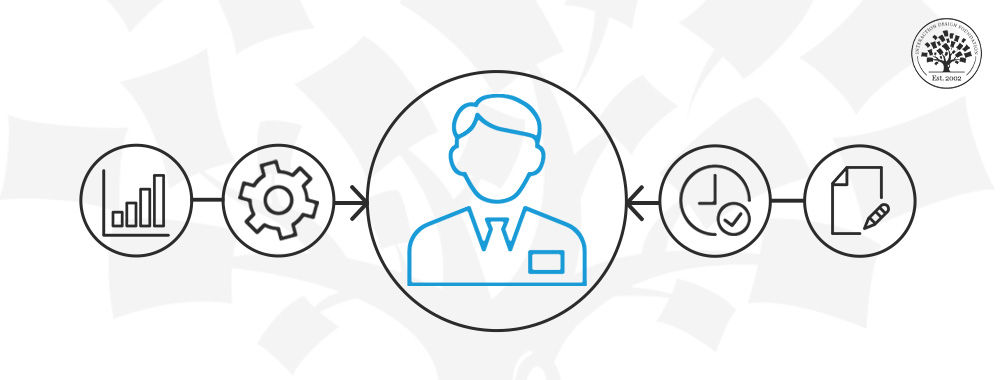Pick any product and you’ll find that product management is vital to how successful it is—and product managers are who make sure that a product’s life cycle runs smoothly, and it means they know how to align strategy, vision, and user needs. Product managers split into multiple roles that have got unique responsibilities—like technical product managers, growth product managers, and more—but stay reading to get a good grounding in product management from a UX (user experience) angle to see what’s involved and how you can involve yourself in an exciting product management role.
What Does a Product Manager Do?
What a product manager does can take many forms—as they don’t just craft a new product’s vision, strategy, and features, but set goals, inspire their team, and prioritize a product’s success in the market, too—and then there’s a profound need to remain vigilant about market shifts and consumer behavior.
At a finer-grained level, though (as in, what a product manager’s day-to-day responsibilities look like), there are the duties where a manager has got to understand user needs, survey the market for competitive insights, and chart out a clear product vision—something that can span many years.
Then, there’s the need to share this vision with leaders, teams, and other interested parties, collect research and feedback about the product, as well as—at least how some organizations do it—take on a project management role, too (though if there’s already a project manager, then product managers work close with them to keep product efforts on track). The product is the offering that the design team create to meet a customer’s need, while a project comprises activities that go towards a specific result—like to add a new feature to an app—so, while a product manager conceptualizes, a project manager (if working separately) makes it “happen.”
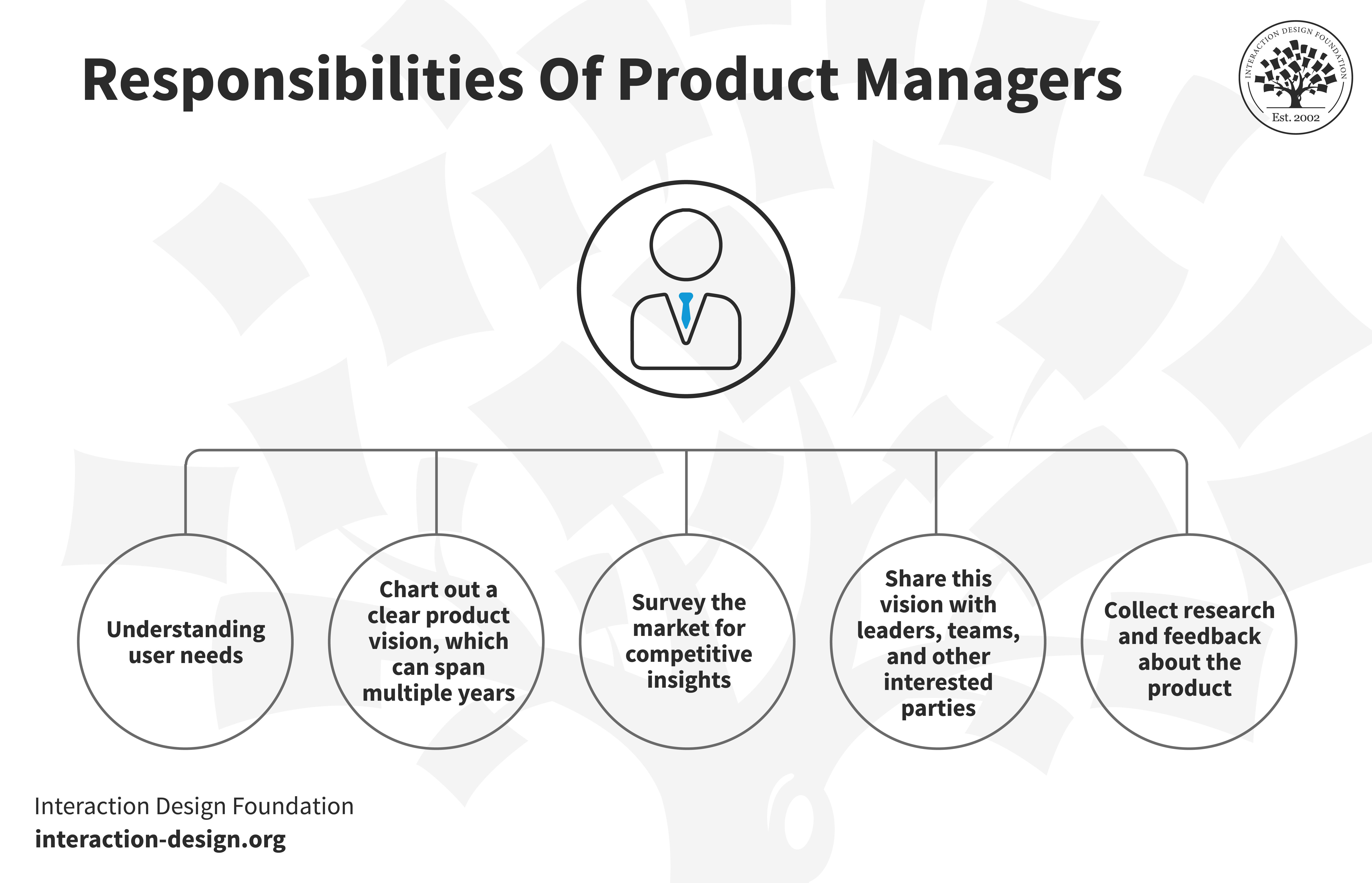
© Interaction Design Foundation, CC BY-SA 4.0
Why is Product Management so Popular?
Product management has seen a (still rising) boost in popularity, and that’s thanks to a shift in companies’ business strategies—where before, businesses leaned heavily on sales and marketing-led growth models, but both of those models came with significant ongoing expenses. Something better needed to be done, and what did come along to counter those costs—and bolster growth, too—was a move towards product-led growth models (PLGs), especially the case in the software-as-a-service (SaaS) sector, where advantages include reduced customer acquisition costs and enhanced growth rates, and all it takes is to look at a couple of statistics to see why SaaS works so well: 34% more SaaS companies adopted PLG strategies in 2021 compared to 2020, and Product Plan’s 2022 report highlighted that 40% of respondents deemed product experience the most critical factor in customer acquisition.
And what this recent change of “heart” that’s seen businesses lean towards product-focused strategies means is—yes, you’re right—the demand for product managers has skyrocketed, again with some figures to show for it:
Interest in product management in the USA doubled between 2016 and 2021.
Product management ranks in the top 10 of Glassdoor’s list of America’s 50 best jobs in 2022.
Tech companies lead in PM recruitment, with a 51% hiring rate.
Unemployment rates for product managers remain nice and low.
Better still, the future of product management looks even brighter for a whole variety of reasons:
Dynamic market conditions: Technological advancements are a foregone conclusion—especially in the digital age—and what that means is there’ll always be a shift in market and user needs. What brands—especially those in the SaaS industry—need more than anything for that is to have product managers who can adapt to these changes.
Human-machine collaboration: Artificial intelligence (AI) is on the rise—and will keep on being for a long time to come—but the need for the human touch will never go away, so it’s not just designers who can breathe easy about not being “replaced.” Product managers, too—as in, human ones!—will need to be there to make sure that this balance with their blend of technical know-how and people skills remains a good balance.
Digital evolution: Product managers are nothing short of essential in the ongoing digital transformation journey—they’re like captains at the helm of their brands’ “ships” in the long, long voyage across giant swathes of “ocean” in this sense, and help their companies navigate with business strategies that can keep them afloat, stable, and agile.
Diverse career opportunities: A background in product management is a kind of “passport” that you can look on to help you throw doors wide open to various roles—and they’re ones that range from associate to senior positions.
Senior executives embrace product leadership: Reports exist that show that 16% of companies have CEOs who’ve got product backgrounds, and 31% have established Chief Product Officer roles, and—not just that—a whopping 55% of firms plan to amplify their investment in product teams; so, you’d be “right on the money” to say that products don’t just produce power—they reflect it, too!
How Long Does It Take to Become a Product Manager?
Fresh Graduates
The academia-shaped path can take from two to five years to get along—and if you’re stepping straight and fresh out of university, you may find it challenging to land a product manager role right away. What tends to happen is this: fresh graduates start at entry-level positions like product associates or junior product managers and then work their way(s) up.
With a bachelor’s degree, it might take two to three years of experience in these roles—or closely related fields like marketing or engineering—before a company considers you for a full-fledged product manager position. If you want to go for an MBA—and many in the area do do that—then that’s another two years on top of it, but you’ll come out of the deal with better opportunities.
Professionals from Related Fields
Great news on this one—people from areas like software development, data analysis, UX design, or business development have got transferable skills in product management, and since they’ve got that all-important familiarity with the product life cycle, user-centered design, or market strategies, they’ve got an advantage.
Watch as UX Pioneer and Author, Don Norman explains important points about user-centered design (UCD):
Show
Hide
video transcript
- Transcript loading…
One thing to note, though, is that to transition to a product manager role, it does call for a holistic understanding of product management—and so, some courses or certifications can help get you that understanding. Depending on what your experience and adaptability are like, you could transition within one to three years.
Experienced Managers from Other Domains
Senior professionals or managers who come from different areas might have leadership, strategic thinking, team management, and technical skills—so, pretty much most of the “package” to cut it in product management. However, one thing where they might fall short is to not have firm grasps of product life cycles or UX design.
Saying that, though, if you’ve got relevant experience, then the best route for you might well be a combination of formal product management training and on-the-job training. And, indeed, if you’ve got managerial expertise, then it can speed the transition process up, though it might take two to four years—depending on how familiar you are with user-centered design—to build up to a complete understanding.
Formal Education and Certifications
Several institutions and platforms offer courses, degrees, and product management certification through programs that range from a few weeks to a few years and provide structured learning and exposure. While they won’t transform someone into a product manager overnight, what they do is greatly bolster the transition—and ease it—especially if they’re combined with real-world experience, so that way means it’s about one to two years of experience as well as how long the course runs for.
Take a look at our learning path and learn how to become a great product manager.
What Factors Influence the Transition Time?
Several ones do, and they include mentorship—not least since when someone’s got a mentor in product management, it can cut down a great deal on the learning curve, and a mentor can give guidance, furnish networking opportunities, and share valuable insights that will be more than a little helpful.
Speaking of networking, that’s another factor—since someone who builds relationships up with the industry can find doors to opportunities thrown open for them, plus get insights on offer from others, not to mention that individual getting to enjoy a faster transition.
Hands-on experience is another big factor—not least since if someone’s taking on product-related tasks, they can roll together invaluable experience that the theoretical stuff can’t transfer to them. Not that the “theoretical stuff” is to be sneezed at, though, and continuous learning especially is a vital thing for somebody to stay updated—plus, if they attend workshops, webinars, and conferences, then they’ll be able to enjoy things speeding up when it comes to their readiness for the role itself.
What it ultimately comes down to, though, is the point that everyone’s on a unique journey, and a passion for products, a user-centric mindset, and determination to get on are going to have a massive bearing pretty much above all else with this career choice.
What Product Manager Skills Are Most In Demand?
It’s fair to say that product managers have got to wear many hats—and happily with no need to be two-faced!—and juggle various responsibilities, and it’s something that calls for a diverse skill set that includes hard and soft skills both, such as these ones.
1. Market & User Research Skills
Research is the backbone of informed decision-making in product management—pretty much mirroring what it does for UX designers, too, but at the product management level it equips managers with insights into customer needs, market trends, and competitor strategies. So, for a product manager to make data-driven choices, validate product ideas, and stay competitive, they’re going to need to have essential market research skills like these ones.
For one thing, there’s data collection, and it goes a long way towards succeeding if a manager knows methods like how to conduct surveys, interviews, and focus groups. Then, there’s quantitative analysis—or “quant” for short—which means they’ve got the ability to interpret statistical data, understand market size, and spot patterns. On the other side of that coin, then, there’s qualitative analysis (“qual”), and it’s a major plus to be able to understand customer sentiments, preferences, and motivations—all that “what makes them tick” know-how that they can bring to bear to get results.
There’s more. A handy knack to have is competitor benchmarking—that ability to look over the fence to see what competitors are up to, and analyze competitors’ products, strategies, and market positions. And then there’s being able to look ahead—namely, trend forecasting and being able to anticipate market shifts and customer behavior changes (and a product manager with a good eye for this can profit their brand well, or at least keep them from coming to grief with missteps in the marketplace or complacency).
Last—but not least—what’s one role that comes to mind for a manager? If you said “facts and figures,” then you’re right on the money—and creating reports is a huge part of it, namely to present findings in a concise, actionable manner that everyone can “get,” get behind, and get moving on.
Watch as Author and Human-Computer Interaction (HCI) Expert, Professor Alan Dix explains important points about qualitative and quantitative research.
Show
Hide
video transcript
- Transcript loading…
2. Technical Proficiency
Tech savviness counts for a great deal, sure, but there’s no need to panic for those who aren’t dev-savvy—and that’s because a product manager doesn’t need to be an expert coder; basic knowledge benefits them. Still, what the tech-facing brain does pay bucketloads of dividends in is how if a manager’s got an understanding of the technology behind the product, they’ll be in a far, far better place to enjoy effective collaboration with their engineering or development team members.
For one thing, a tech-savvy manager will be able to communicate much better about product features, and—because they’ll get their minds around what’s involved at the science level of things—they can be so much sharper when they set realistic timelines and (another biggie) make sure there are feasible product requirements to work with so what comes out can come out as planned.
3. Roadmapping Skills
Roadmaps are vital tools on the—excuse the mixed metaphor—runway for a product to take off from, and a comprehensive roadmap helps get everyone on the team in line with upcoming features, timelines, and the broader product vision.
Not just that, it offers stakeholders (who tend to include businesspeople who’ve often got no real—or not a very deep—grounding in techy or even “designy” aspects) that vital clarity of view on the project, like what the precise context is and how things are going timeline-wise. What’s more, though, a roadmap gives a panoramic perspective of what the product’s future trajectory is going to be like, and that insight can help in resource allocation and the level of focus everyone can put on where to concentrate their efforts best.
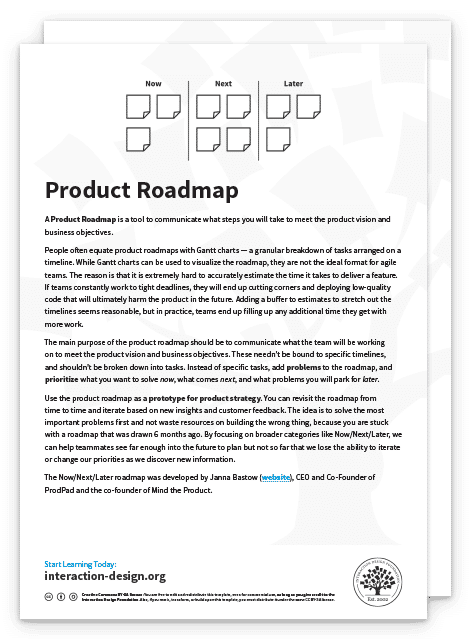

4. Proficiency in Data Analysis and Research
Next on the list is how a product manager has got to be good at interpreting and applying data; and this is where an analytical mind comes in handy since—far from confining the number crunching to the maybe more “purist” area of, say, statistics—a mindful product manager takes it onward and combines strategy with flexibility. A manager who’s good at this can use their skill as a kind of fulcrum to lever plusses like risk management benefits from statistics, market insights (and how they influence pricing), and financial evaluations (and how they guide the distribution of resources) into place to the maximum benefit of their brand.
Watch as UX Strategist and Consultant, William Hudson explains how to fit quantitative research into the project lifecycle.
Show
Hide
video transcript
- Transcript loading…
A good product manager uses that goal-driven mindset to be data-centric—and, from that, user-centric—and tracks key metrics like customer conversion, user attrition, customer satisfaction, and feature uptake, all crucial to evaluate product success, functional efficiency, and user satisfaction with. What’s more—and another strength of top product managers—is how a strong product manager can enjoy self-sufficiency and not need to rely on team analysts to feed them with the data they need to make well-informed decisions.
5. Strategic Thinking Skills
Strategic thinking is a trait that shows where planning and business knowledge meet at a high place, and a product manager who thinks that way can get the product roadmap well in line with the broader company vision, and that’s what helps make product-led growth happen for real.
Then, there’s a SWOT analysis—analyzing Strengths, Weaknesses, Opportunities, and Threats—which shows strategy-led thinking in true action, and a mastery of strategic thinking means product managers who can make well-timed decisions, set achievable targets, and pivot and adapt as situations call for them to.
6. Prioritization Skills
To be in charge of things and do them well, a good product manager has got to excel at managing resources—particularly time—and that’s why making some things priorities over others is so vital a skill to be good at. So, a product manager is adept at “triaging” the issues that need immediate action, the needs of some projects above others, the sequence of tasks to get them done, and the areas that are vital to achieve excellence in so that what comes out as the results are spot on with what needed doing.
7. User-Centric Approach
A brand stands—or falls—on what its users and customers think of it, and companies build every successful product around the people who use it—hence why successful product managers understand users’ needs, desires, habits, and challenges. It takes actively listening to customers, empathizing with their worlds (and especially pain points), framing the product as their much-needed solution, and it’s here where tools like CRM, micro surveys, usability testing, and focus groups help product managers in this process. For extra “points” for this category, a product manager who knows UX well—or, to pinpoint things, UX management, research, and design in particular—can get a sharper view to assess products and spot areas to improve it.
Consider Netflix. It started as a DVD rental service and pivoted into a streaming giant. Product managers at Netflix are the ones who get to oversee the platform's user experience, and what they use is data analytics to understand viewing habits, and that data-driven approach informs decisions that run from interface changes to shows the team needs to renew.
8. Communication Skills
This “soft skill” can produce hard results, and it’s not for nothing that effective communication—in the form of verbal and written skills—is a must-have, not least as product managers represent the product within the company and beyond. They’ve got to be able to pitch the product vision to internal teams—like engineering, sales, marketing, finance, and external clients—and product managers handle crucial written documents like technical product specs, too.
That’s why it takes active listening to be able understand others’ views and to respond well and make decisions that are impactful. Then, there’s the negotiating skills side, and a product manager has got to be able to argue over resource limits if they and their teams are to get to their goals, plus the ability to push back and be assertive to cut or decline tasks that stray from core objectives.
9. Emotional Intelligence
It takes having a good EQ as well, and emotional intelligence refers to the ability to recognize, understand, manage, and respond to one’s own emotions and the emotions of others. In this “bucket” are self-awareness and self-regulation, which are vital for one to understand one’s own moods and emotions, but also being able to manage and control those, especially in stressful situations (good managers don’t “lose it” or “fly off the handle”). Outside of that, there’s motivation—or the drive to achieve for the sake of it—and empathy, which is vital to understand the emotional makeup of others and how they see things.
Part and parcel of having a healthy EQ is the social skills factor, too, as building relationships and managing interactions with others is going to prove vital every step of the way, to navigate social complexities, get others on board, and influence the environment the manager is in—not to mention bring out the best in people and keep high standards in the conflict resolution “department.”
Watch our video to get a deeper view of empathy in design—and designing environments.
Show
Hide
video transcript
- Transcript loading…
10. Stakeholder management
Great PMs—to use the abbreviation for product managers—are ones who build authentic, trustworthy ties with stakeholders as they inspire and empower them to do well—and they’re vital bonds for effective negotiation, conflict resolution, and aligning diverse teams to get everyone on board towards common objectives.
Yes, it’s a bit of a balancing act, but it’s a crucial one whenever product managers have to juggle customer demands, engineering constraints, and revenue targets, and when PMs build—and maintain—solid internal relationships, they can enjoy reinforced backing (or loyalty!) during critical product stages of if they’re persuading (rather than trying to “twist the arm of”) a developer to do an urgent fix. On the external side of the equation, they can motivate customers to test or try out early product versions, so it “pays” to be trustable, likeable, persuasive, and “good at people.”
11. Storytelling
Storytelling can transform work into art—and although this one may just come as a surprise at the management level, a product enthusiast captivates audiences with vision and persuasive storytelling, and that’s something that helps spark excitement for the product. It’s normal to be passionate about your product, to be sure, as it paves the way to being a visionary—and it takes being curious about industry trends, getting involved in critical dialogues, and getting a deep and palapable understanding of your product’s market.
Show
Hide
video transcript
- Transcript loading…
7 Crucial Steps to Become a (Better) Product Manager
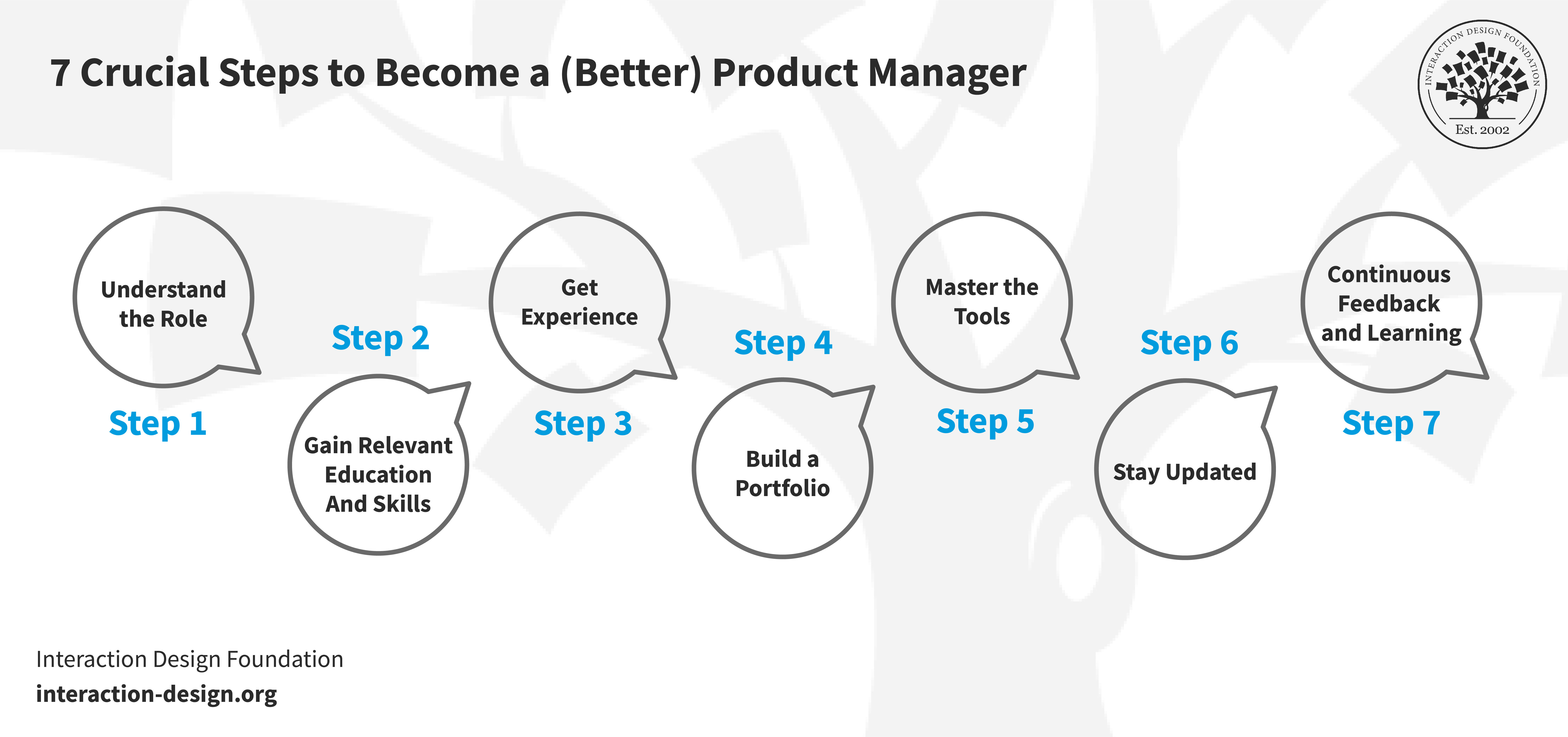
© Interaction Design Foundation, CC BY-SA 4.0
Step 1 - Understand the Role
Before starting your product manager career—and once you’re sure if this career is for you to begin with—you’re going to need to have enough knowledge about the field and get a clear picture of it, too, and that’s where some self-study works well if you look up blogs, read books, and listen to podcasts with a focus on understanding:
Step 2 - Gain Relevant Education And Skills
First the “bad” news: there’s no fixed degree for product management, but (the good news!) study business, technology, or design and it can help a great deal.
If you’re more into flexible learning, though, then you’ve got online options to pick from, too, and the IxDF offers courses tailored for aspiring product managers, which can boost your knowledge and make your journey into product management smoother.
Step 3 - Get Experience
Start in roles related to product management—like marketing, design, or engineering—and this experience will be quite precious as it’ll help you to build up an understanding of different aspects of product development. What’s more, where you work can offer up plenty of chances to learn about products, so it pays to see about shadowing a UX designer, a product designer, a web developer, or—and, why not—a product manager, or at least chat with them over coffee or an informative Zoom call. Speaking of being online, participate in online communities and get to know other course-takers who are into product management, too—it can pay dividends of a big kind.
Learn what makes a product designer different from a UX designer.
Step 4 - Build a Portfolio
As you learn and start implementing your skills, you’ll make way for creating a relevant portfolio for the product manager role, and—a nifty bonus—you can showcase relevant projects even if you haven’t held a PM role; the thing is to showcase “what” you work on and “how” you work on it. So, it’s more than just a good idea to document product-related initiatives you’ve taken (from minor features you’ve ideated to user flows you’ve designed); include challenges that got in the way, solutions you proposed, and what came of your efforts (those all-important outcomes). And if you don’t have real-world examples, no problem—just make up hypothetical product case studies and describe a problem, your process, and then your solution.
Like a UX designer’s—as in, in the idea behind it—a well-curated portfolio demonstrates your approach, thinking, and problem-solving abilities as a PM or a prospective one. It’s a tool—and kind of an “ambassador” of you as a “brand” in your own right—so you’ve got to keep the portfolio updated, visually engaging, and concise—and that’s because it’ll travel ahead of you and potential employers value tangible evidence of your skills and capabilities.
Take inspiration from top product manager portfolios:
Step 5 - Master the Tools
Tool know-how and problem-solving approaches go hand-in-hand, so be sure to familiarize yourself with platforms like Jira for task management, Figma for design collaboration, or Trello for project tracking—not least since being proficient in these tools can give you a real edge. It’s not only about knowing how to use them, though—it’s also about understanding how they can streamline processes and enhance team collaboration and getting how they show how committed and ready you are to get that PM role.
And you can go to webinars, watch tutorials, or take short courses to help with that, but remember to stay updated as new tools—and newer features of existing tools—can turn up in the market fast.
Step 6 - Stay Updated
Keep on keeping up to date as to what you know about product management—not least since the tech and product worlds go through rapid changes, as do best practices. Subscribe to leading PM blogs, follow industry experts on social media, and participate in webinars, and engage in discussions on platforms like Product Hunt or Product Coalition to keep a pulse on emerging trends.
Attend industry conferences to gain insights from the frontlines. This ongoing learning enriches your skillset and helps you bring the most current and practical strategies to your role. Being updated enables you to network better and contribute to conversations and discussions.
Step 7 - Continuous Feedback and Learning
A well-established feedback loop, where you collect, analyze, and act upon insights, helps you improve your work. It’s not about receiving feedback but understanding and implementing it. In your initial days, you must treat your mistakes as learning opportunities.
The product management field involves a steep learning curve. Thus, staying open to feedback ensures you remain on the right trajectory. You can cultivate relationships that encourage open communication and make it a habit to seek input.
Education has evolved with technology, and platforms like the IxDF, Coursera, or Udemy need constant content updates, interface enhancements, and user experience refinements.
The average salary for a product manager
According to Glassdoor, the average total compensation for a Product Manager in the United States is approximately $147,058 per year—and one thing this figure includes is a base salary of around $111,241 every year (Glassdoor takes the figures from its unique Total Pay Estimate model using median values gathered from user submissions).
Then, on top of the base salary, a product manager can expect an estimated extra compensation of $35,817 a year, and what that includes is elements like bonuses, commissions, and profit sharing; a tidy sum to have for something you’re good at and enjoy doing.
Career Path of a Product Manager
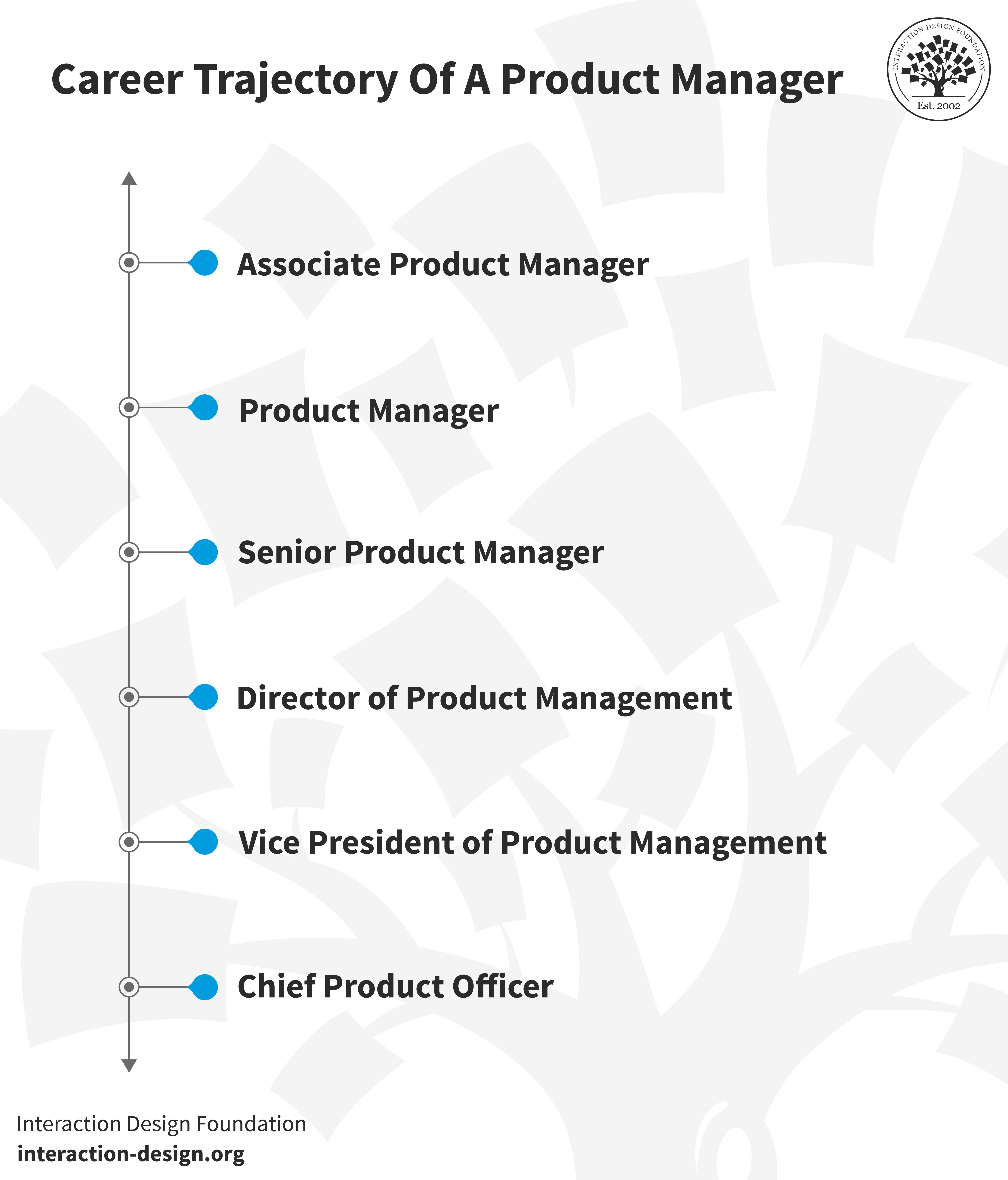
© Interaction Design Foundation, CC BY-SA 4.0
1. Associate Product Manager
Starting in product management, you get the entry-level role of an Associate Product manager, and this position is one that lets you understand the product market and its consumers, and you report to senior product managers and perform data analysis and user interface (UI) design tasks—all sound foundations to build upon.
2. Product Manager
As the central figure in the product life cycle, Product Managers are the ones who oversee the product from start to release—and they manage the roadmap for timely delivery and plan the product’s development, plus they collaborate with UX, engineering, and marketing teams to ensure a seamless process happens for real.
3. Senior Product Manager
With added experience comes the title of Senior Product Manager, and they’re the individuals who handle high-profile product launches and mentor junior product managers—they connect their team with the organization’s upper management as a bridge for smooth communication and execution.
4. Director of Product Management
Then there’s the Director of Product Management, and they step into a leadership role and get more involved in strategic oversight; and what their primary focus is is to align the product’s—or product line’s—strategy with the company’s objectives, and to get the product team on board with the direction and rationale; pretty important (and rewarding) responsibilities.
5. Vice President of Product Management
Then, at this executive level, the Vice President of Product Management juggles budgeting, marketing strategy, and resource distribution tasks, and their role’s a crucial one in adjusting product strategies to align with the company’s vision—and get them well in line with that vision—so that profitability and progress flow forth in abundance. For these higher-level PM professionals, there’s an added bonus when they’ve got effective communication—which is an essential thing as they don’t just present the product vision but need to rally support for it too.
6. Chief Product Officer
The Chief Product Officer reports to the CEO and guarantees that the company’s product strategies do resonate with its overarching goals and values, and with at least a decade’s product management experience, and experience in analytics, marketing, and UX, they’re professionals who oversee every facet of product design and its eventual launch; so getting to enjoy the associated prestige from a high-flying launched product that does more than a little well in the marketplace.
Consider how Telehealth platforms have gained prominence, especially post-pandemic, and companies like Teladoc offer virtual medical consultations, and product managers in such firms have got to make sure that the platform is user-friendly for doctors and patients—calling for security to protect patient data and follow medical regulations.
Reasons to Choose This Career Path: A Product Manager Success Story
Read how Bianca's journey to becoming a Product Manager (PM) began with a keen sense of self-awareness.
The Take Away
Product management is an attractive field, and people aspire to get into this role because of not just its impact but its growth potential, too, and there’s the chance of getting in on the action with a mega-hit of a market release. Depending on what your experience and education are like, there are various ways in to product managerial roles, which are different from, say, project managers—though it’s not mandatory to have an MBA, though specific educational backgrounds do give an edge.
There are a fair few skills a product manager needs to bring to the table, including soft skills like communication, and the tech industry is ripe and prime for PMs to join. Product management calls for a mix of soft and hard skills, and continuous learning—as well as awareness of the industry—are vital things to succeed with.
Get started on how to become a great product manager with 15 courses in four parts.
